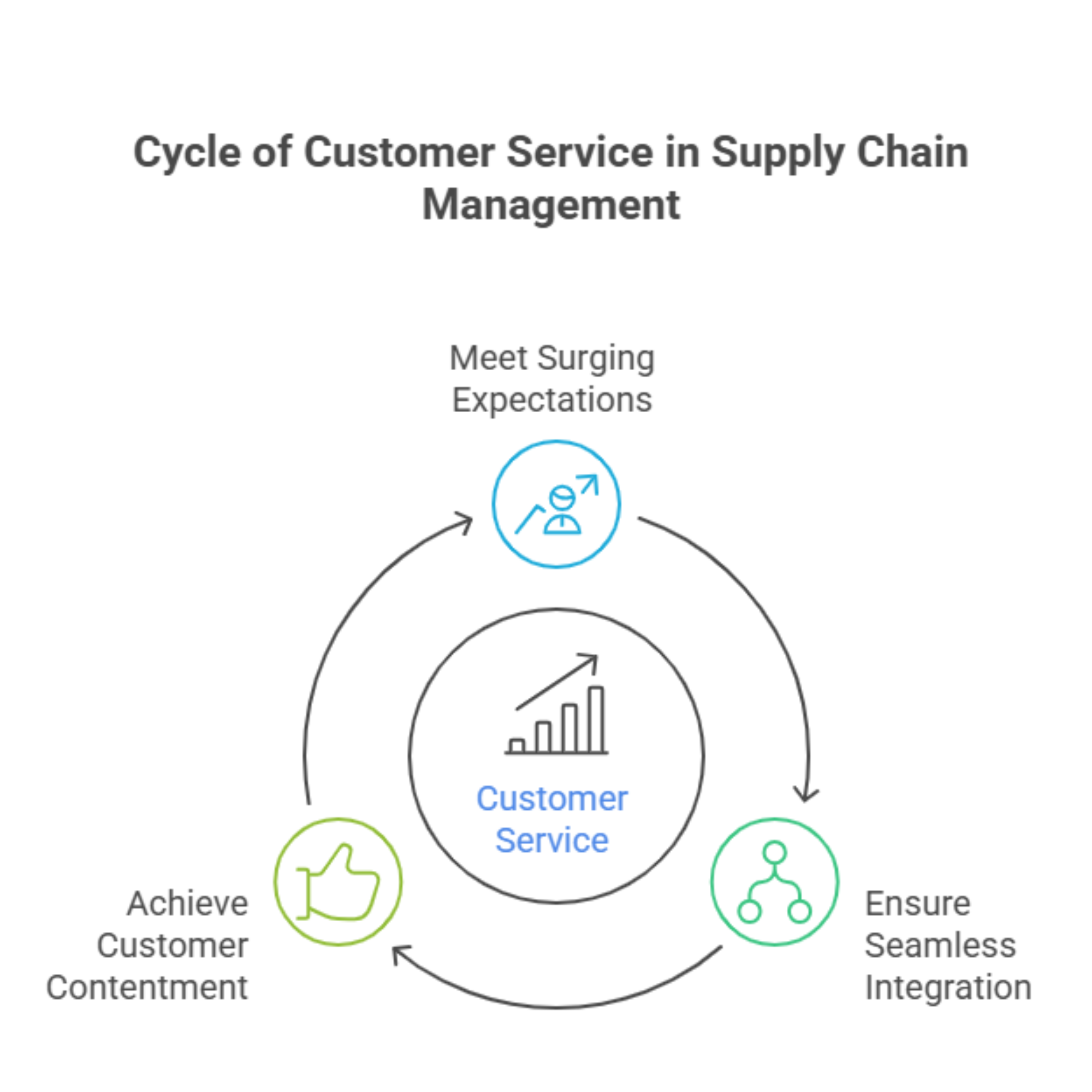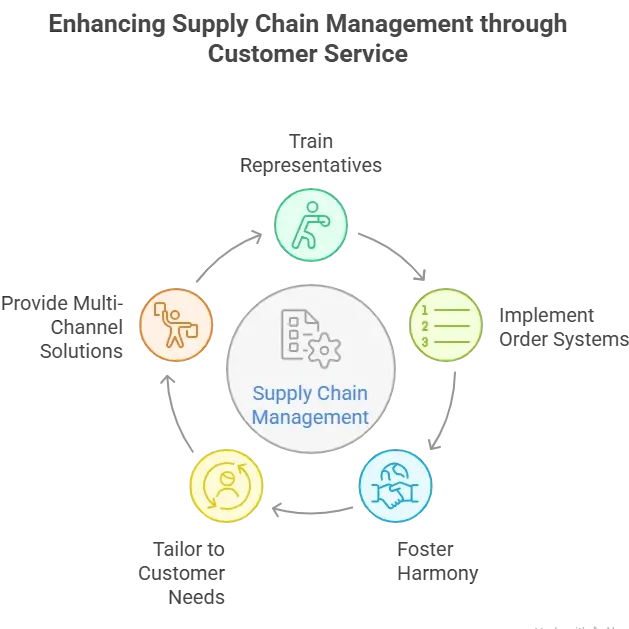
69% of individuals opt out of further engagements with a company due to subpar customer service. And the number isn’t even surprising, because customer retention is the single most important factor that’ll either make or break your business in 2024. While we jest about it, quality customer service undeniably shapes business outcomes. In today’s information age, word spreads rapidly, and reputations can flourish or falter based on customer interactions. That’s why modern businesses prioritize integrating customer service into their supply chain. While customer service typically takes centre stage, the supply chain operates behind the scenes. In this blog, we will talk in detail about the role of customer service in supply chain management. Let’s begin!
Customer Service in Supply Chain Management
Customer service in the supply chain involves meeting customer needs seamlessly from order to delivery. A Geodis survey found that about 70% of businesses recognize the complexity of their supply chains.
Central to this concept is the ability to understand and anticipate customer requirements, promptly address concerns, and surpass expectations. Effective communication, responsiveness, and a dedication to delivering quality products or services within deadlines are paramount.
A key focus area is order management, encompassing accurate processing, proactive order tracking, and transparent communication on status updates or potential delays. Timely updates foster trust and satisfaction.
Efficient logistics operations are essential, including inventory management, streamlined warehousing, and reliable transportation to ensure on-time deliveries. Proper packaging, labelling, and documentation further enhance the customer experience.
Handling customer issues, returns, or exchanges promptly demonstrates a commitment to satisfaction and loyalty. Leveraging technology such as CRM systems and automated communication tools aids in managing interactions and providing real-time updates effectively.
Role of a Customer Service Representative
Customer service representatives are pivotal in ensuring a smooth and satisfying customer journey within the supply chain. Serving as frontline communicators and issue solvers, they bridge the gap between customers and different supply chain departments.
Their core duties include promptly addressing customer inquiries, providing updates on orders, and resolving issues throughout the order fulfilment process. Additionally, they facilitate order placement and collaborate with logistics and inventory teams for timely delivery.
Furthermore, they serve as customer advocates, gathering feedback and conveying insights to enhance overall satisfaction.
Features of Customer Service in Supply Chain Management

1. Surging Expectations
With the rise of modern communication platforms, connecting with beloved brands is now effortless. Many brands utilize social media as a direct channel to engage with customers, setting high standards for customer service.
Slow responses or silence won’t cut it anymore; customers expect transparency, honesty, and timely solutions. With vast access to information, customers demand expertise and won’t tolerate ignorance. Empathy is key too; while the customer isn’t always right, their concerns should be taken seriously.
Delays are detested; most customers anticipate responses within six hours on social media and want swift resolutions. Neglecting customers signals indifference and risks damaging your brand’s reputation in the long run.
2. Seamless Integration
While the supply chain operates discreetly, integrating it closely with customer service proves beneficial. Connecting customer service with order systems allows reps to efficiently address customer concerns by accessing comprehensive order information.
Many businesses invest in warehouse management systems and automation to streamline operations, ensuring efficient order fulfilment and enhanced customer experiences. Transparency is maximized as orders are tracked from packaging to delivery, benefiting both customers and representatives.
3. Customer Contentment
Ultimately, the primary role of customer service within the supply chain is to ensure customer satisfaction. Failure to satisfy customers across product quality, delivery speed, communication transparency, and service proficiency can lead to lagging behind competitors.
Even with quality leads, unsatisfied customers hinder conversion rates. Successfully meeting customer demands for excellence in every aspect fosters peak customer satisfaction. Integrating this satisfaction into the supply chain facilitates business growth and attracts new customers.
Ways to Enhance Supply Chain Management Using Customer Service

1. Training Reps for Success
Train customer service representatives (CSRs) to identify and resolve customer pain points effectively. Equip them with sales skills and comprehensive product knowledge for better problem-solving. A standardized company manual ensures consistent training for all staff.
2. Introduce Order Systems
Integrate customer service with order entry systems to improve order fulfillment and enhance customer satisfaction. Streamlining delivery processes enables CSRs to provide real-time updates on package status, fostering positive experiences.
3. Increase Harmony
Ensure a uniform customer experience across all subsidiaries by aligning customer service and supply chain practices. Consistent training on company values and standards ensures cohesion and eliminates disparities between different locations.
4. Tailoring Supply Chain to Customer Needs
Adapt the supply chain to meet customer needs effectively, from purchase to delivery. Collaborate with packaging and transportation teams to accommodate specific customer requirements, ensuring a seamless and personalized experience.
5. Multi-Channel Customer Service Solutions
Enhance accessibility to customer service through various communication channels like social media, website chat, and phone. Empower the support team to deliver exceptional service across all platforms, ensuring swift and efficient resolution of customer inquiries along the entire supply chain.
Conclusion
In conclusion, customer service in supply chain management plays a pivotal role in ensuring seamless operations and customer satisfaction. Meeting evolving customer expectations, integrating with order systems, and prioritizing customer contentment are essential.
At Qodenext, we understand the significance of efficient supply chain management and offer tailored solutions to enhance customer experiences. With a dedicated focus on customer service excellence, businesses can thrive and build lasting relationships with their customers in today’s competitive landscape.
FAQs: Role of Customer Service in Supply Chain Management
1. What does a transaction fee for a Shopee seller mean?
A transaction fee for a Shopee seller refers to the percentage of each sale retained by Shopee as commission for using their platform to facilitate the transaction, typically ranging from 1% to 5% depending on the product category.
2. Does the seller pay for the shipping fee?
Yes, typically, the seller bears the shipping fee unless stated otherwise in the product listing where the shipping cost might be shared or entirely covered by the buyer.
3. What is the best way to ship products?
The best shipping method depends on factors like product size, weight, destination, and customer preferences. Popular options include standard courier services, express delivery, or specialized services for fragile items.
4. How to ship products for cheap?
To ship products affordably, consider negotiating bulk rates with shipping carriers, utilizing flat-rate shipping options, optimizing packaging for size and weight, and exploring consolidated shipping services or regional fulfilment centres for cost-effective delivery.
5. Why is customer service important in supply chain management?
Customer service is crucial in supply chain management because it ensures smooth order processing, timely delivery, and effective issue resolution. It helps build customer trust, enhances satisfaction, and improves retention — all of which directly impact a company’s growth and reputation.
6. How can technology improve customer service in the supply chain?
Technology, such as CRM systems and automated communication tools, improves customer service by enabling real-time updates, seamless order tracking, and faster response times. It enhances transparency, minimizes human errors, and ensures customers stay informed throughout the order cycle.
7. What role do customer service representatives play in the supply chain?
Customer service representatives act as a bridge between customers and supply chain departments. They handle inquiries, track orders, resolve issues, and provide updates, ensuring customers receive accurate information and a positive post-purchase experience.
8. How can businesses enhance customer satisfaction through supply chain management?
Businesses can enhance satisfaction by training staff, integrating order systems, ensuring transparency, offering multi-channel support, and personalizing delivery options. A responsive and well-integrated supply chain creates a smooth experience that keeps customers loyal and satisfied.







